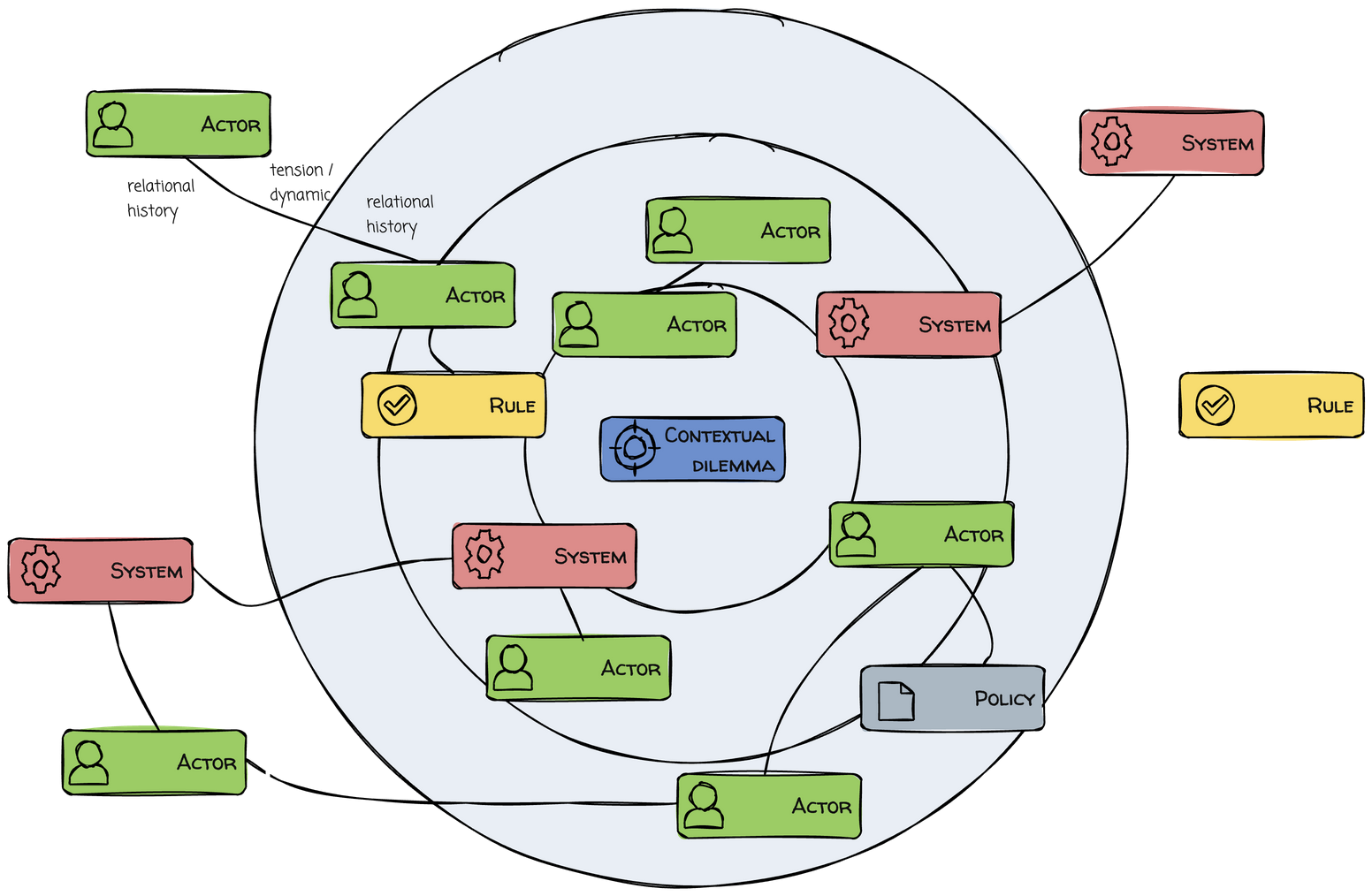Relational Terrain Mapping
If we are working across a complex web of actors and systems, and we map their relational proximity, perspectives, and tensions, then we tend to surface critical dynamics that shape the work, enabling more adaptive, grounded, and coherent movement.
Most mapping tools show who’s involved, but not how they actually relate. In complex systems, what shapes outcomes isn’t just structure, it’s the lived dynamics of trust, history, tension, and belief. The Relational Terrain Map reveals this messy, emotional, power-sensitive landscape. It makes visible the field of connection, contradiction, and meaning so teams can act with awareness, not assumption.
How to use this pattern
A dynamic sensemaking constellation of the system’s lived terrain:
Define the Shared Situation
Start with a generative question, challenge, or problem space. Place it at the centre of the map.
Identify the Actors and Forces
Include people, roles, teams, communities, users, policies, constraints, norms, power structures—and their relational significance.
Go beyond formal roles. Ask:
• Who is emotionally affected by this work?
• Who is entangled in loops of action, blame, or care?
• Who is present but silenced? Who is absent but implicated?
Treat users not just as groups, but as relational actors with memory, hope, frustration, and strategies of survival.
Map by Proximity
Position actors by:
proximity to the issue (how entangled or impacted they are)
proximity to others (based on trust, friction, history, neglect)
Draw Relational Lines and Tensions
Connect actors who are meaningfully entangled. Consider not only formal interaction, but emotional proximity, power difference, and interpretive distance.
Annotate each end with relational history:
• beliefs, assumptions, or emotional posture (e.g. trust, avoidance, fear, duty)
• known silences or taboos
In the middle, name the tension or dynamic. Examples include:
• “We’re expected to collaborate but distrust each other’s motives”
• “They feel unheard; we feel constrained”
• “The system counts them, but doesn’t see them”
Explore Dynamics
Through storytelling or facilitated dialogue, explore:
What does this relationship enable or inhibit?
Where is politeness masking tension?
What beliefs are in play here?
Label Terrain Types and Clusters
Spot emerging clusters or logics: e.g., “compliance mindset,” “user advocacy,” “delivery realism.” These become terrain markers.
Generate Next Moves
Use each cluster as a starting point for Probe Storming. Ask: What if we worked with this tension instead of trying to resolve it?
Affordances
Shows power, influence, and belief on the same map
Makes visible what’s felt but unnamed: emotions, histories, informal dynamics
When users are mapped as relational agents, not passive recipients, design work surfaces deeper tensions, latent needs, and informal dynamics that standard journey maps miss.
Mapping only formal relationships or using abstract role labels flattens meaning
Stances
Inquirer. This stance prompts the mapping, asking questions like "who are the key players in this situation?" or "how do different relationships influence outcomes here?" It guides the initial exploration of the relational landscape.
Challenger. This stance is crucial during the mapping process, encouraging participants to question their assumptions about relationships and to expose any "elephants in the room" or unspoken tensions that might be influencing the terrain.
Synthesiser. This stance helps to connect the individual relationships and influences depicted on the map into broader patterns of connection, disconnection, or power dynamics within the system. It helps to find coherence in the complex web of interactions.
Noticer. Attuned to subtle emotional responses and unspoken cues, including from those not in the room. Senses underlying currents, relational harm, or user experiences that are present but unnamed.
Facilitator. This stance guides the group through the process of building the relational map, ensuring that all perspectives are respectfully shared, that the visual representation accurately reflects the collective understanding, and that the conversation remains productive.
Steward. This stance holds the intention for the ongoing use of the relational map, ensuring that insights gained contribute to a deeper understanding of the system's relational health and inform future efforts to build healthier connections.
Shaper. If the map reveals a critical relational bottleneck or an opportunity for new connections, this stance helps design small, targeted probes or interventions aimed at influencing these dynamics in a constructive way.
Craftsperson. This stance ensures that the relational map is created with care, accuracy, and a commitment to honest representation, making it a reliable and useful artefact for the community's ongoing inquiry into its social landscape.

